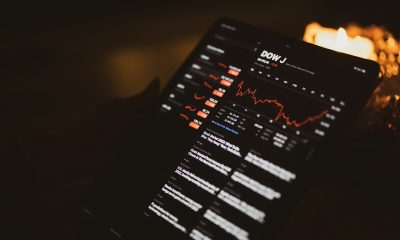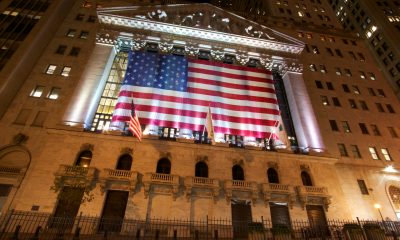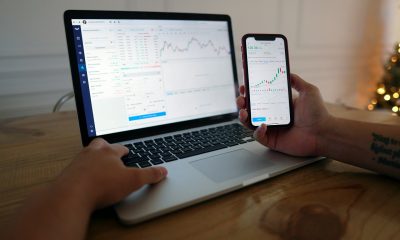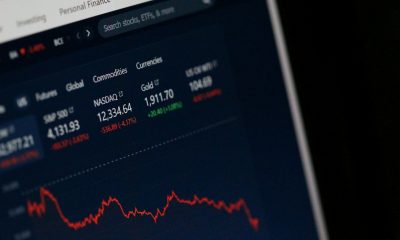Markets
AI-Fueled Rally Mirrors Past Bubbles as Gold Gains on Rising Uncertainty
AI-driven tech optimism echoes past bubbles like the 1920s and 1990s, with warning signs emerging in banking, auto loans, and real estate. S&P 500 ratios now favor gold and silver, highlighting shifting sentiment. Ongoing U.S. data gaps, a government shutdown, and fragile global ceasefires add uncertainty, boosting gold amid rising geopolitical and political tensions.
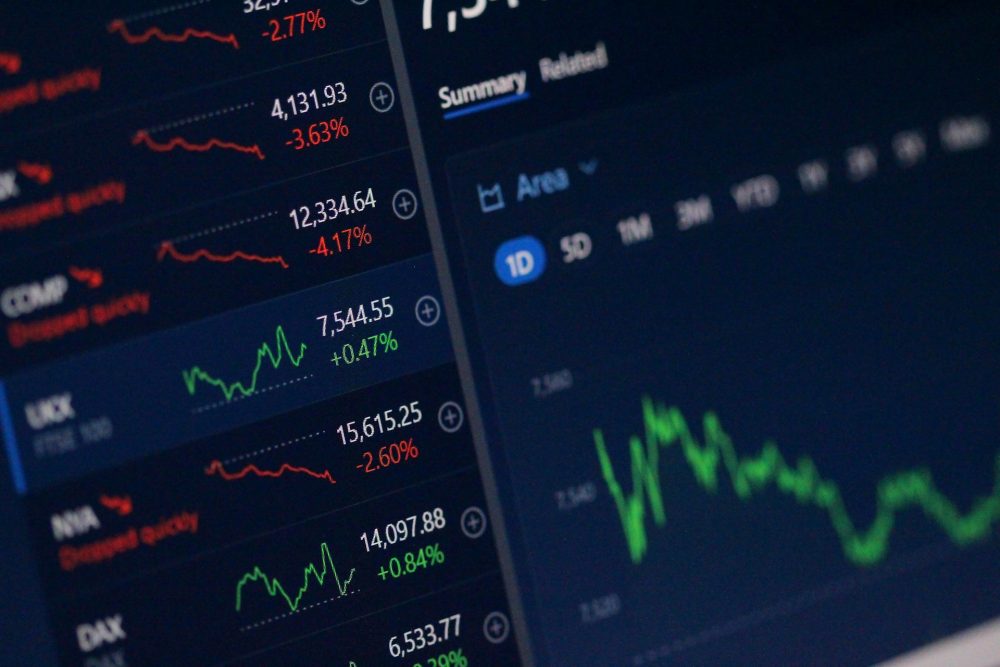
The Roaring Twenties may be the best-known stock market bubble of all time. Following World War I, the Spanish flu pandemic, and the recession/depression of 1918–1921, the stock markets went on a party binge. It was a technological boom period with the advent of automobiles, radio, talking pictures, medical breakthroughs, and more; it was the period of the flappers, the Jazz Age, prohibition, and Babe Ruth in baseball; it was a period of an economic boom but it was also a period of growing inequality, the rise of radical groups, and the rise of feminism with women getting the right to vote.
They thought it would never end. But it did. The crash of October 1929 was followed by the Great Depression when unemployment soared, tariff wars between countries got underway, and, a severe economic contraction occurred. The period also saw the rise of nationalist fascist movements, particularly in Italy, Germany, and Spain as well as communism in Russia. What followed after was World War II where 70 million were killed.
It can be difficult to pinpoint when it started, but the bottom of the market in 1921 appears to be a good place to start. From that low, the market rose an amazing 497%. It wasn’t straight up, with a 19% correction in 1923–1924 and another dip, but not as much in 1926.
Dow Jones Industrials 1921–1932

DJI Performance 1923-1929

Source: www.stockcharts.com
The second chart shows the return but on a close basis rather than high to low as the top chart shows. The crash came in October 1929 and the market fell some 48%. A rebound did get underway into April 1930 but it didn’t last, failing the previous top. Then began the long Great Depression collapse, the most devastating bear market ever as the Dow Jones Industrials (DJI) fell 86%. No major stock market has ever touched that record, although the NASDAQ tried after the dot.com/high-tech boom of the 1990s.
Dow Jones Industrials 1982–2002

DJI Performance 1990-2000

Source: www.stockcharts.com
The 1920s saw a technology boom and the 1990s were no different. This time it was the internet, DVDs, text messaging, MP3 players, numerous software programs and services such as Adobe Photoshop, Google, and much more. That in turn triggered the dot.com/high-tech bubble of the 1990s. From that low in 1982 the DJI rose an incredible 1,462%. The real tech boom got underway in 1994 and from there the DJI soared 334%. The NASDAQ, where many of the high-tech companies were listed, rose 643%. In order to put the 1990s bull on a roughly equal basis with the 1920s, we went back to a key low in 1990. From there the DJI rose 372%.
While the 1990s dot.com bubble did not result in a crash comparable to the 1930s, it was finally pricked, as all bubbles are, and the markets fell. In between came the events of 9/11 (September 11, 2001) where the stock exchanges closed for a few days. That in turn launched the War on Terror and the invasion of Afghanistan in 2001 and later Iraq in 2003. The bubble burst when everyone realized many companies were overvalued, with questionable earnings and unsustainable business models.
Markets peaked, first in January 2000 for the DJI and then in March for the S&P 500 and the NASDAQ. The NASDAQ suffered the most, with a 78% decline from March 2000 to October 2002. That collapse compared well with the 86% drop of the DJI from 1930–1932. It proved once again that what goes up comes down even faster.
Dow Jones Industrials 2009–2025

DJI Performance 2016-2025

Source: www.stockcharts.com
It is not difficult to understand why this era is seeing its own version of the 1920s and 1990s technology bubbles. Oodles of money from quantitative easing (QE), ultra-low interest rates as a result of the 2008 financial crisis and then the 2020 pandemic were the fuel. Technology advancements were the reason.
Technology has been led by AI along with cloud computing, biotechnology advancements, smart phones, 3D printing, tablets (e.g., the iPad) 4G and now even 5G mobile network technology, blockchain (crypto), electric cars, drones, and more. That in turn appears to be behind the third bubble of the past hundred years that is technology driven. Will it end like the other two?
We were tempted to add a fourth, that being the Nifty Fifty bubble of the early 1970s. Like today, technology led the way. Data transmission, analog voice channels, computer networking, satellite communications, lasers, and optical fibres all emerged from that era. All good but for markets the era was very uneven. The DJI suffered a 25% decline after peaking in 1966. Then another 36% decline got underway in 1968 before bottoming in 1970. Yes, the markets bounced back, but then along came another 16% decline in 1971 before the market soared to its January 1973 top, led by what was known as the Nifty Fifty a group of NYSE stocks that were the darlings of institutional investors.
It was the choppiness of markets that prompted us to leave that era off. As well, the DJI, unlike other periods, was not soaring to new highs much, even in 1972. Unlike the current market and the 1920s and 1990s, it was not primarily straight up. The prime reasons for the eventual 45% decline of 1973–1974, along with the steep recession at the time, was triggered by the Watergate scandal and the Arab Oil Embargo not so much the overvaluation of the technology boom.
At the time, oil played a much bigger role in the global economy than it does today, thus the huge negative impact that the embargo sparked. The period is worth mentioning given the technology boom, but unlike today, the 1920s, and 1990s, a technology collapse was not the prime reason for the collapse.
As to the current market, will it result in the same ending as in 1929 and 2000? The technology of the 1920s and 1990s left an indelible mark on the world and changed it forever. But overvaluations and over-optimism saw those markets collapse. After all, bull markets are born in pessimism, grow in skepticism, mature in optimism, and die in euphoria. Are we still in the optimistic stage or are we in a state of euphoria? Right now, earnings are good and appear to just keep on rising.
The economy overall is just not growing. If it was growing, it was coming from money printing. But even that has subsided. Lurking behind are geopolitical worries, domestic political worries, growing nationalism, and the rise of extreme right parties, events that could trigger World War III, trade wars, and more. No wonder gold is soaring, but momentum is slowing considerably on global stock markets.
Notice as well that, while the booms of the 2010s and 2020s look good, they lag the others. Since the major low in 2009, the DJI has gone up 623%. When we compare the rise for the 1990s and the 2010s on a similar basis as the 1920s (similar time frame), we noted the 1920s rose 483%, the 1990s were up 372%, while the current period dating from the lows of 2016 is up only 182%. The pandemic collapse of 2020 may have been short-lived, but it was significant.
Stock market bubbles don’t grow out of thin air. They have a solid basis in reality, but reality as distorted by a misconception. —George Soros, Hungarian-American investor and philanthropist, the man who broke the Bank of England; b. 1930
What will be the trigger that will burst the bubble this time?
Trouble in the hinterland?
Is there trouble brewing in the regional banks? Reports of credit quality problems and troubles in the commercial real estate sector and the subprime auto loans market are causing some unease here.

Source: www.stockcharts.com
First off, the collapse of a few regional banks is not in itself going to trigger a major market sell-off. Regional banks have collapsed before, notably in 2023 when First Republic, Silicon Valley Bank (SVB), and Signature Bank all went under. Banks mentioned this time include Zions Bancorp, Jeffries Financial, and Western Alliance. Subprime auto lenders First Brands and Tricolor are amongst those going under. Jamie Dimon, the CEO of JP Morgan Chase calls them “cockroaches.” Are there more? Where there is one there are usually more.
Nonetheless, shares in majors such as JP Morgan, Wells Fargo, and Bank of America along with Deutsche Bank were being somewhat pressured. Deutsche Bank fell about 6%. The large money center banks are not the problem. Today, they are better capitalized than they were during the 2008 financial crisis, so they are better able to handle some regional bank collapses. Still, markets dipped during previous banking issues and they could do so again.
The U.S. Bank Indices

Source: www.stockcharts.com
Chart of the Week
S&P 500/Gold Ratio 1970–2025

Source: www.stockcharts.com
S&P 500/Silver Ratio 1970–2025

Source: www.stockcharts.com
Usually what we show is the Dow Jones Industrials (DJI)/Gold or Silver ratio. Instead, we are using the S&P 500 (SPX), a much broader market to measure things. No surprise – the chart of SPX/Gold/Silver is similar to DJI/Gold/Silver. Before 1970, the ratios bottomed in 1932 and topped in 1966, matching the stock market bottoms and tops at the time. Nonetheless, the ratios are quite useful in measuring whether one should be in the stock market or, instead, in gold and silver (and related stocks).
Thus, it is no surprise that, because of the run-up in gold and silver prices during the 1970s, coinciding with a difficult period for stocks, the ratio bottomed in 1980 with gold peaking at $875 and silver near $50 (the infamous Hunt Brothers attempt to corner the silver market). The 1970s was an inflationary period (stagflation), coupled with recessions in 1969–1970, 1974–1975, and culminating in the 1980–1982 steep recession.
The 1980s and 1990s saw the two flip places as stocks roared and gold and silver languished. The period culminated in the dot.com/high-tech bubble of the late 1990s. The 2000s was a period of turmoil with the 2001–2002 recession, followed by the global financial crisis and Great Recession of 2007–2009. It was also a period of war with the 9/11 attacks and the subsequent wars in Afghanistan and Iraq. Wars that became never-ending.
After the ratio bottomed in 2011 with gold over $1,900 and silver again near $50, a period followed where stocks ruled over gold and silver, thanks to ultra-low interest rates and QE. The wars in Afghanistan and Iraq continued but eventually ended. We now appear to be culminating in the AI bubble, not dissimilar to what happened in the late 1990s. It’s against the background of geopolitical and domestic political instability. Both the SPX/Gold ratio and the SPX/Silver ratio have now firmly broken to the downside, suggesting another period of gold and silver outperforming stocks.
Based on the topping patterns, the SPX/Gold ratio could fall to at least 0.78. Holding SPX steady at 6,715, the level at time of writing, it suggests gold could rise to $8,600, some 100% above current levels. As for silver, the pattern is similar and again holding the SPX at current levels of 6,715 the ratio could fall to 36.45, suggesting silver could rise to $184, some 250% above current levels.
The targets could change, depending on the value of SPX going up or down. Both targets are above the lows seen in 1980 and 2011. If somehow the ratios reached those lows, gold’s targets could be $50,000 and silver’s target $3,000, both based on the 1980 low. As to the 2011 low, gold’s target could be $11,300 and silver at $260. Again, that’s based on holding SPX steady at 6,715, the current level at time of writing.
Both gold and silver (and gold stocks) are currently going parabolic. That’s a dangerous market and we are quite overbought. A correction could occur, even a sharp one. However, the breakdown in both the SPX/Gold ratio and the SPX/Silver ratio implies both gold and silver have the potential for considerably more gains as the ratios fall relative to the SPX.
Markets & Trends
| % Gains (Losses) Trends | ||||||||
| Close Dec 31/24 | Close Oct 17/25 | Week | YTD | Daily (Short Term) | Weekly (Intermediate) | Monthly (Long Term) | ||
| S&P 500 | 5,881.63 | 6,664.01 | 1.7% | 13.3% | up (weak) | up | up | |
| Dow Jones Industrials | 42,544.22 | 46,190.61 | 1.6% | 8.6% | up (weak) | up | up | |
| Dow Jones Transport | 16,030.66 | 15,676.28 | 4.0% | (1.4)% | neutral | neutral | up | |
| NASDAQ | 19,310.79 | 22,679.97 | 2.1% | 17.5% | up | up | up | |
| S&P/TSX Composite | 24,796.40 | 30,108.48 (new highs) * | 0.9% | 21.8% | up | up | up | |
| S&P/TSX Venture (CDNX) | 597.87 | 965.58 (new highs) | (1.6)% | 61.8% | up | up | up | |
| S&P 600 (small) | 1,408.17 | 1,434.27 | 3.0% | 1.9% | down | up | up | |
| MSCI World | 2,304.50 | 2,784.54 | (1.8)% | 20.8% | down (weak) | up | up | |
| Bitcoin | 93,467.13 | 106,505.49 | (3.4)% | 14.0% | down | up (weak) | up | |
| Gold Mining Stock Indices | ||||||||
| Gold Bugs Index (HUI) | 275.58 | 636.88 (new highs) * | 3.9% | 131.5% | up | up | up | |
| TSX Gold Index (TGD) | 336.87 | 756.15 (new highs) * | 3.8% | 124.5% | up | up | up | |
| % | ||||||||
| U.S. 10-Year Treasury Bond yield | 4.58% | 4.01% | (0.7)% | (12.5)% | ||||
| Cdn. 10-Year Bond CGB yield | 3.25% | 3.10% | (2.2)% | (4.6)% | ||||
| Recession Watch Spreads | ||||||||
| U.S. 2-year 10-year Treasury spread | 0.33% | 0.54% | 1.9% | 63.6% | ||||
| Cdn 2-year 10-year CGB spread | 0.30% | 0.72% | 2.9% | 140.0% | ||||
| Currencies | ||||||||
| US$ Index | 108.44 | 98.42 | (0.4)% | (9.2)% | up | down (weak) | down | |
| Canadian $ | 69.49 | 0.7135 | flat | 2.7% | down | neutral | neutral | |
| Euro | 103.54 | 116.70 | 0.5% | 12.7% | down (weak) | up | up | |
| Swiss Franc | 110.16 | 126.14 | 0.8% | 14.5% | up) | up | up | |
| British Pound | 125.11 | 134.33 | 0.6% | 7.4% | down (weak) | up | up | |
| Japanese Yen | 63.57 | 66.44 | 0.5% | 4.5% | down | down l | down | |
| Precious Metals | ||||||||
| Gold | 2,641.00 | 4234.22 (new highs) * | 5.4% | 60.3% | up | up | up | |
| Silver | 29.24 | 51.74 (new highs) * | 3.5% | 77.0% | up | up | up | |
| Platinum | 910.50 | 1,604.90 (new highs) | 0.4% | 76.3% | up | up | up | |
| Base Metals | ||||||||
| Palladium | 909.80 | 1,494.50 (new highs) | 4.6% | 64.3% | up | up | up (weak) | |
| Copper | 4.03 | 4.95 | 3.1% | 22.8% | up | up | up | |
| Energy | ||||||||
| WTI Oil | 71.72 | 57.55 | (1.2)% | (19.8)% | down | down | down | |
| Nat Gas | 3.63 | 2.99 | (4.5)% | (17.6)% | down (weak) | down | neutral | |
Source: www.stockcharts.com

Source: www.stockcharts.com
Is the bull market of 2025 coming to an end? Seems that every week we’d note new all-time highs. Not this week as, following the sharp down reversal last Friday, October 10, we rebounded but have so far failed to regain the highs. Is the bloom off AI? Well, not quite as the NY FANG Index made new all-time highs but MAGS the MAG7 ETF failed to make new highs. Maybe Advanced Micro helped the FANG Index as AMD gained 8.5% on the week. Broadcom was up 7.6% so that probably helped as well. Neither are members of MAGS. We don’t want to get too bearish too soon as we’ve been burned before. But this seems to be the first time in weeks we are not making new all-time highs.
Signs abound the economy is slowing. The US government shutdown is now 19 days old and we could easily be threatening the longest shutdown of 35 days seen during Trump 1 administration 2018-2019. Protests are rising on the street as the “No Kings” march of October 18 attracts many protests in cities and potentially millions of participants. Trump is threatening war with Venezuela, the country with the world’s largest oil reserves, and Venezuela is putting its military on high alert.
The U.S. is saddled with $37.9 trillion of debt, the largest in the world, and there are signs of banking problems developing. Manufacturing indices have been falling. What’s worse, the key agencies that measure the labour market and inflation are all shut down. We don’t know what is going on. All this could be an excuse to sell.
On the week, the S&P 500 rose 1.7%, the Dow Jones Industrials (DJI) was up 1.6%, the Dow Jones Transportations (DJT) was up 4.0%, and the NASDAQ was up 2.1%. All good? Except they fell short of their recent all-time highs. The S&P 400 (Mid) gained 2.0% while the S&P 600 (Small) was up 3.0%. The S&P 500 Equal Weight Index rose 1.6% while the NY FANG Index was up 2.8% to all-time highs. In Canada, the TSX Composite made all-time highs but closed well short of those highs, although it was still up 0.9%. The TSX Venture Exchange (CDNX) didn’t fare as well as it made new 52-week highs but closed down 1.6%.
In the EU, the London FTSE fell 0.8%, the Paris CAC 40 was up 3.2% despite the turmoil in France, the German DAX fell 1.7%, and the EuroNext gained 1.9%. In Asia, China’s Shanghai Index (SSEC) was down 1.5%, the Tokyo Nikkei Dow (TKN) fell 1.9%, while Hong Kong’s Hang Seng (HSI) fell 4.0%. The MSCI World Index (ex-USA) fell 0.2%.
We’ve already broken the up-trend line from April 2025 and sit on the edge of breaking under the 50-day MA at 6,564. If we break 6,550, then the next level of support is at 6,200. Under that level a top is confirmed.
We can’t fully say a top is in, but given this is October and we remember 2018 well when the stock market fell into year end, we can’t ignore the failure to make another new high. New highs would, of course, keep the party going.
The Scorecard
Selected Performance Since Inauguration Day 2025

Source: www.stockcharts.com
Our scorecard since Inauguration Day on January 20, 2025 remains the same. Gold is comfortably in the lead, up 57.4%, while oil brings up the rear, down 25.5%. Everybody else appears to be turning down. Bitcoin is close to turning negative. Gold took that tumble on Friday but, as we will explain, we need a further decline to suggest a top. The US$ Index is the only other one in negative territory, down 9.9%.

Source: www.stockcharts.com
Like the U.S. stock markets, has the TSX made a top? Naturally, we can’t quite say that yet. A break under 30,000 would suggest the top is in. Under 29,000 we confirm a top is in. Nonetheless, it was another record week for the TSX. However, the surge to the top followed quickly by a down move suggests trouble ahead. The TSX Composite did gain 0.9% this past week. Only one sub-index was down on the week: Energy (TEN), down 2.6%. Leading the way up was Information Technology (TKK), gaining 3.2% to new all-time highs.
Also making all-time highs were Golds (TGD) +3.8%, Materials (TMT) +2.0%, Utilities (TUT) +1.7%, and Financials (TFS) +0.3%. TFS may have closed the week up, but it tumbled 2.4% from its weekly high and left what we call a gravestone doji on the charts. A gravestone doji is formed when the stock/index opens jumps to a high, then closes back at the opening, leaving what looks like a gravestone on the charts. It’s like an upside-down T. It normally signals a potential top and a down move ahead. Buyers may have pushed it up, but the sellers came and pushed it right back down again.
Elsewhere, the TSX Venture Exchange closed the week down 1.6% after it made new 52-week highs. The CDNX is home to numerous junior companies in mining, gold, technology, real estate, etc. Gold and mining stocks make up a good half of the index. Many have been on a tear before profit-taking set in. The CDNX was up some 90% from that April 2025 low. Some junior gold mining stocks leaped 400%. At a high of 1,037 the CDNX was just short of the 2021 high of 1,114.
However, Thursday saw a sharp reversal that was an outside day and on Friday the CDNX gapped lower. All this suggests a top is in. The huge overbought conditions that have gone on now for three months were another danger sign. No, we don’t believe the rise in the CDNX is over, but a pause would be refreshing to reassess. Note how volume surged upward into the recent highs. The CDNX is attracting attention but investors still need a refresher as the early birds take some profits.

Source: www.stockcharts.com
The Canadian stock markets need a breather from their breakneck runs to new highs/all-time highs. The pause that refreshes. Could it be a major top? Yes, but for that we need the TSX and the CDNX to bust the April 2025 low to confirm.

Source: www.stockcharts.com
Is Bitcoin on the edge of a major breakdown? It looks that way, given another week of a sharp down taking out the lows of the past four months. The pattern has the look of a triple top. The potential target, given it has already broken the pattern when it fell under $110,000, is down to $90,550. There is another trendline to take out under $100,000.
A break under that June 2025 low of $98,300 would send Bitcoin tumbling further. Note volume has picked up on the decline, suggesting some force behind the move. Bitcoin has a history of huge run-ups followed by huge declines. That happened in 2017–2019, down 84%, and again in 2021–2023, down 74%. Buyer beware.
U.S. 10-year Treasury Note, Canada 10-year Bond CGB
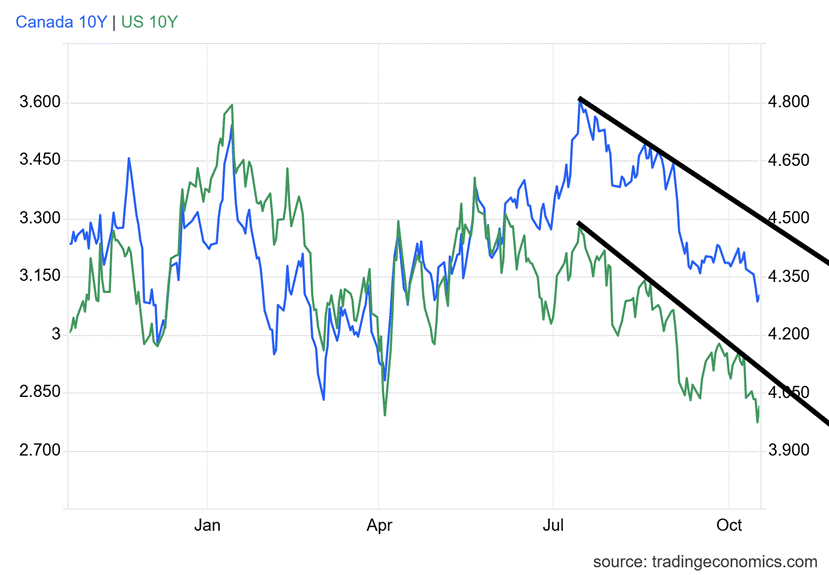
Source: www.tradingeconomics.com, www.home.treasury.gov, www.bankofcanada.ca
Shakiness in the banking industry, particularly with the regional banks, and the collapse of subprime auto lender Tricolor and the auto parts supplier First Brands helped push bond yields lower this past week. Banks such as JP Morgan Chase announced loan losses. Bond yields are also falling because of trouble in the labour market as claims are soaring (if we could actually get the numbers, given the BLS is shut down).
The U.S. economy may be slowing further, but we won’t know for sure until the government shutdown ends, given it shows no sign of opening again as the two sides are dug in and blaming each other. The drop in yield was small, from 4.05% to 4.01%, but still significant. Canada fell further, down to 3.10% from 3.17% as BofC Governor Tiff Macklem is signalling the potential for further rate cuts, given we aren’t yet seeing the impact of the trade wars. Canada contracted 1.6% in Q2. But, taken with Q1, Canada did eke out slight growth.
For the U.S. 10-year, all that remains is that April 2025 low of 3.86% to take out. After that, the September 2024 low was 3.60%. Certainly, the combined whammy of potential bank problems and the weakening labour market helps push bond yields lower as investors rush to safety. What’s concerning, however, is the jump in the Secured Overnight Financing Rate (SOFR) that has leaped to 4.3% and is now above the 10-year rate.
Overnight money being higher suggests a tightening of credit in the market. The rate is now also above the Fed’s target rate of 4.25%. That is rare, but it reflects the growing troubles in the bank and labour markets.
U.S. 10-Year Treasury Note vs. the Secured Overnight Financing Rate (SOFR)
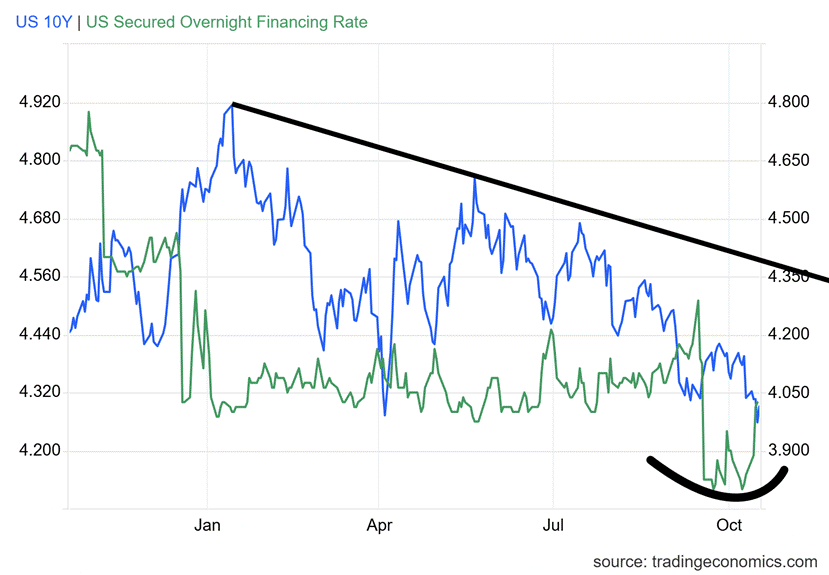
Source: www.tradingeconomics.com, www.home.treasury.gov
Falling long rates but rising short rates suggests the yield curve could invert. Nonetheless, that wouldn’t be confirmed until the 2-year note rose above the 10-year note. So far, it is only the really short rates out too one month that has moved in line or above the 10-year. But it is worth keeping an eye on. It reflects a tightening of credit in the market and could in turn spark a credit crunch.

Source: www.stockcharts.com
Currency movements were pretty benign this past week with only small moves. The US$ Index fell 0.4% as news of the bank problems arose. The euro rose 0.5%, the Swiss franc was up 0.8%, the pound sterling was up 0.6%, and the Japanese yen up 0.5%. The Cdn$ was flat on the week. The Swiss franc is viewed as a currency safe haven and leads to the upside with a gain of 14.5% thus far in 2025. The US$ Index stalled at the 165-day EMA and rests on support of the 50 and 100-day MA.
The 200-day MA is way above at 100.95. Looming closer are the July and September lows of 96.38 and 96.22 respectively. We still have the look of a bottoming pattern; however, we need to firmly break above 100.25 to suggest we are headed higher. Currently, it is as if we are in a holding pattern as they try to figure out which way the US$ Index should go. We await breakouts to confirm.

Source: www.stockcharts.com
When the talking heads stop talking about AI and note the huge run-up in gold prices, and talks of $5,000 or higher get louder, it’s no surprise that one can get whacked thinking we are just going to keep going up forever. Gold made what looks like an outside day key reversal on Friday. If that’s correct, it could definitely signal a top, even if it turns out to be just temporary. What a day – we closed down $77.82 Friday, but the day range was $189.60. Can’t say we’ve seen that before.
We’ve noted before that we could be expecting a low in the November/December period. And Friday’s action is signalling that’s a real possibility. We note that gold at $1,045 in December 2015 was an important 7.8-year cycle low. Next up was the low at $1,613.60 in September 2022 which was 6.8 years from the 2015. That’s 81 months, which is a bit shy of Merriman’s (www.mmacycles.com) range for the 7.8-year cycle of 86–102 months.
There was a secondary low in October 2023 at $1,809.50 and it was from that level that the current run-up got underway. That’s 94 months from the December 2015 low. That fits better. If that is correct, then the next 7.8-year cycle low is due around 2030/2031. That means we are early in the cycle and this appears to be forming a 31-month cycle low, the first of three over the next 7/8 years. As a result, after this correction we should move higher once again.
On the week, gold made new all-time highs again at $4,379. Some softening of the stance against China helped, along with ceasefires in Gaza (that won’t last) and talks of a ceasefire in Russia/Ukraine. Still, the reversal left gold up 5.4% on the week and 60.3% on the year. Silver gained 3.5%, also to all-time highs and up 77% on the year. Platinum joined the party, up 0.4% on the week to new 52-week highs. Platinum is up 76.3% in 2025. Of the near precious metals, palladium gained 4.6% to new 52-week highs while copper was up 3.1%. A great week for the precious metals, but then came Friday, spoiling the party.
A correction is coming. It is not such a bad thing because, as we note, it should be temporary, although it could easily last into year end. It’s been a great year for the precious metals, so some profit-taking seems reasonable, expected, and overdue given the overbought conditions.

Source: www.stockcharts.com
Was Friday an outside day key reversal for silver? Silver made a new all-time high on Friday at $54.45, then reversed and closed below the low of the previous day at $51.88, down 4.3% on the day. The previous day’s low was $52.48. That fits the definition of a key reversal. Grant you, we’ve seen these patterns bust before we’d have to wait and see if we break under $47 to confirm the breakdown. We’ve been very overbought for weeks now. So, a correction is overdue. Despite it all, silver still managed to close up 3.5% on the week. It was the biggest drop for silver in six months on Friday despite silver ending the week up.
There was an apparent shortage of silver in London, which gave way to silver prices going into backwardation (spot prices above the nearest futures contract). That was still the case on Friday; however, it had eased somewhat. Despite it all, silver has surged 77% in 2025. But the more recent moves seem to be too much, too fast, too soon. Hence, profit-taking may be in order. Support is seen at around $43 and that might not be an unreasonable target. The former high near $50 could also be support and it would be a good spot for silver to consolidate. Silver could just gap down on Monday, so be aware.

Source: www.stockcharts.com
It has been quite a year so far for the gold stocks. Both the Gold Bugs Index (HUI) and the TSX Gold Index (TGD) are up over a 100% this year with the HUI last up 131.1% and the TGD up 124.5%. But are we now facing an overdue correction? It appears that is possible as both indices spiked this past week to new highs, then turned down on Friday with the HUI losing 7.3% and the TGD down 7.2%. It was the worst one-day loss for those indices we can remember.
That didn’t stop them from making new all-time highs once again and closing up on the week with the HUI up 3.9% and the TGD up 3.8%. Sounds great. They endure a big down day Friday and still close up on the week.
But what about next week? Follow-through to the downside would not be a surprise as we try to work off some of the overbought conditions. A healthy correction could be 20%. We saw that occur on the march in 2010–2011 to new all-time highs. The 200-day MA for the HUI is at 413 while for the TGD it is at 504. From current levels that would be down 35% for the HUI and down 34% for the TGD. We don’t think it will be that bad but it does point out the downside risk. And it can occur in a hurry. The word seems to be to take some profits. A breakdown under 718 and under 700 would signal lower prices for the TGD. Under 660 would signal even lower prices.

Source: www.stockcharts.com
Fear of a global economic slowdown, a glut of oil worldwide, and a potential easing of the geopolitical situation all helped oil prices lower this past week. WTI oil fell 1.2% while Brent crude was off 1.4%. On the year, WTI is down 19.8% while Brent is off 18.0%. First, the geopolitical situation. A ceasefire was declared for Israel/Gaza and hostages were returned, but the ceasefire is extremely fragile and many expect it not to hold as breaches have already occurred.
More interesting is the potential for a ceasefire between Russia/Ukraine, suggested by Zelensky himself. The ceasefire would be along current lines, something Ukraine and Zelensky have consistently said is not happening. Maybe not getting the Tomahawk missiles that Zelensky wanted helped push it along?
Add in the U.S. upping the tariffs on China and signs of a global economic slowdown and you have another nail in oil’s coffin. Adding to the potential for a slowdown are more U.S. sanctions on Russian oil companies There is also the small matter of a glut of oil on the world market. All of it is a recipe for lower oil prices. And that means lower prices at the gas pump. That the U.S. reserves need to be replenished is one of the few notes that oil prices could rise. If all the ceasefires fail, then once again oil could rise. But right now, there is too much conspiring against oil to push prices higher. Lower is more likely. Right now, all that remains are the April/May lows of $56.06 and $56.46.
Even natural gas (NG) prices are being pressured lower with NG at the Henry Hub down 4.5% this past week, even as NG at the EU Dutch Hub was up a small 0.1%. Mild weather and ample storage are helping NG go lower. Both oil and NG may be sitting on some support, but the recent oil lows and the NG lows are close and could fall. Nonetheless, energy stocks are holding in, even as the ARCA Oil & Gas Index (XOI) actually rose 4.6% this past week while the TSX Energy Index (TEN) fell 2.6%. Both indices, however, remain well above their recent lows, unlike oil and gas. That remains a positive for the energy market. We are also approaching the best period for oil and gas: December to June.
Copyright David Chapman 2025
__
(Featured image by Anne Nygård via Unsplash)
DISCLAIMER: This article was written by a third party contributor and does not reflect the opinion of Born2Invest, its management, staff or its associates. Please review our disclaimer for more information.
This article may include forward-looking statements. These forward-looking statements generally are identified by the words “believe,” “project,” “estimate,” “become,” “plan,” “will,” and similar expressions, including with regards to potential earnings in the Empire Flippers affiliate program. These forward-looking statements involve known and unknown risks as well as uncertainties, including those discussed in the following cautionary statements and elsewhere in this article and on this site. Although the Company may believe that its expectations are based on reasonable assumptions, the actual results that the Company may achieve may differ materially from any forward-looking statements, which reflect the opinions of the management of the Company only as of the date hereof. Additionally, please make sure to read these important disclosures.
David Chapman is not a registered advisory service and is not an exempt market dealer (EMD) nor a licensed financial advisor. He does not and cannot give individualised market advice. David Chapman has worked in the financial industry for over 40 years including large financial corporations, banks, and investment dealers. The information in this newsletter is intended only for informational and educational purposes. It should not be construed as an offer, a solicitation of an offer or sale of any security. Every effort is made to provide accurate and complete information.
However, we cannot guarantee that there will be no errors. We make no claims, promises or guarantees about the accuracy, completeness, or adequacy of the contents of this commentary and expressly disclaim liability for errors and omissions in the contents of this commentary. David Chapman will always use his best efforts to ensure the accuracy and timeliness of all information. The reader assumes all risk when trading in securities and David Chapman advises consulting a licensed professional financial advisor or portfolio manager such as Enriched Investing Incorporated before proceeding with any trade or idea presented in this newsletter.
David Chapman may own shares in companies mentioned in this newsletter. Before making an investment, prospective investors should review each security’s offering documents which summarize the objectives, fees, expenses and associated risks. David Chapman shares his ideas and opinions for informational and educational purposes only and expects the reader to perform due diligence before considering a position in any security. That includes consulting with your own licensed professional financial advisor such as Enriched Investing Incorporated. Performance is not guaranteed, values change frequently, and past performance may not be repeated.

-

 Markets7 days ago
Markets7 days agoMixed Market Trends as Global Coffee Growing Conditions Improve
-

 Africa2 weeks ago
Africa2 weeks agoForeign Investor Activity in Morocco’s Equity Market in 2024
-

 Fintech4 days ago
Fintech4 days agoPayPal Under Fire: Excessive Data Collection and Privacy Concerns in Advertising
-

 Biotech2 weeks ago
Biotech2 weeks agoJohnson & Johnson’s Tecvayli Combo Shows Breakthrough Results in Multiple Myeloma
